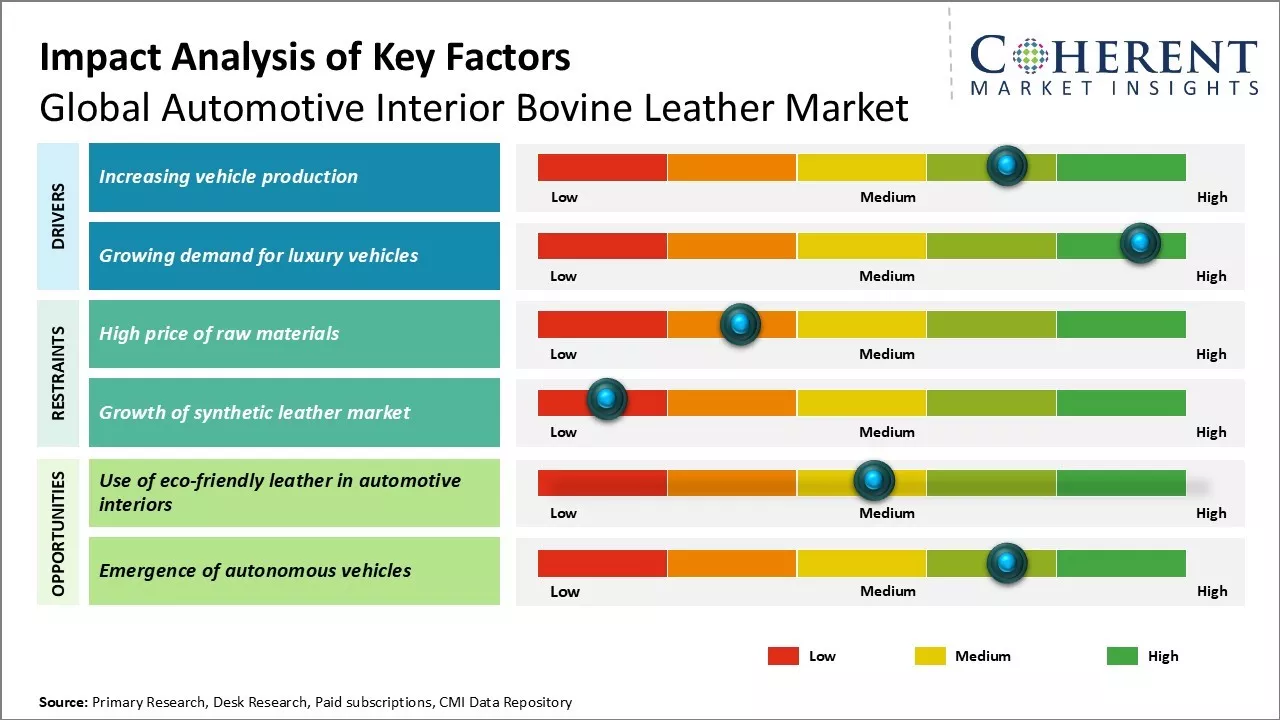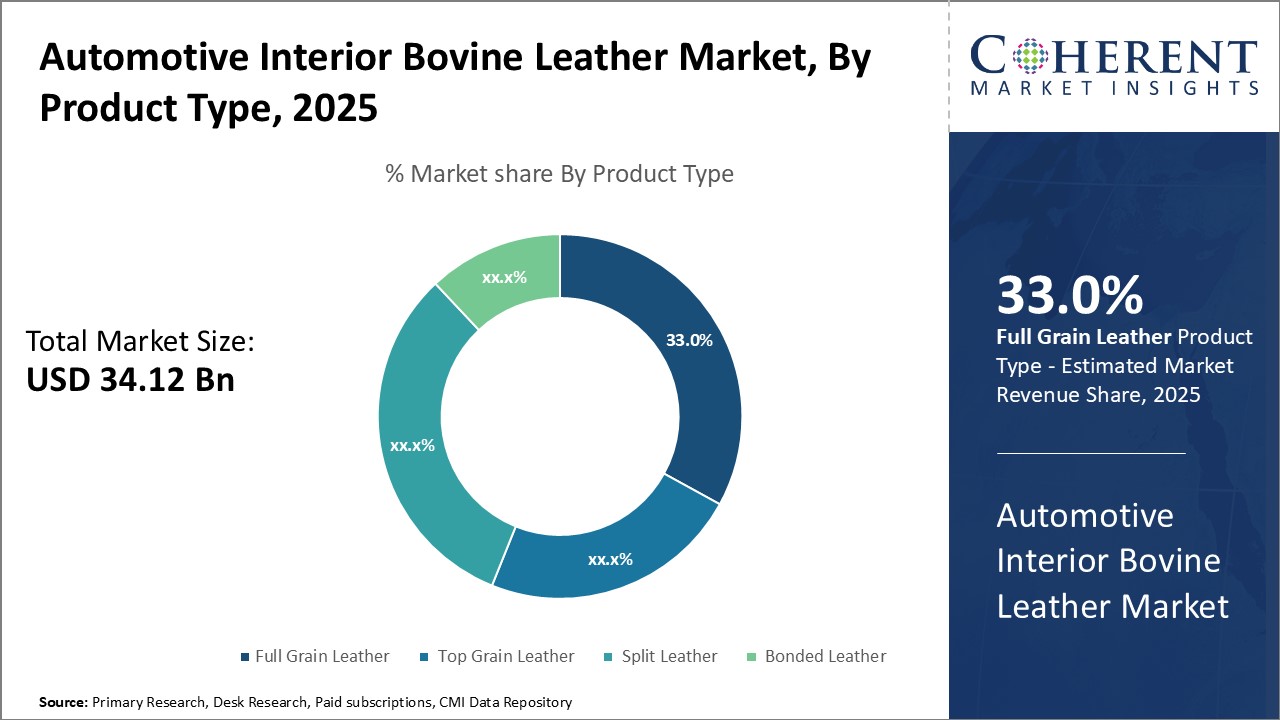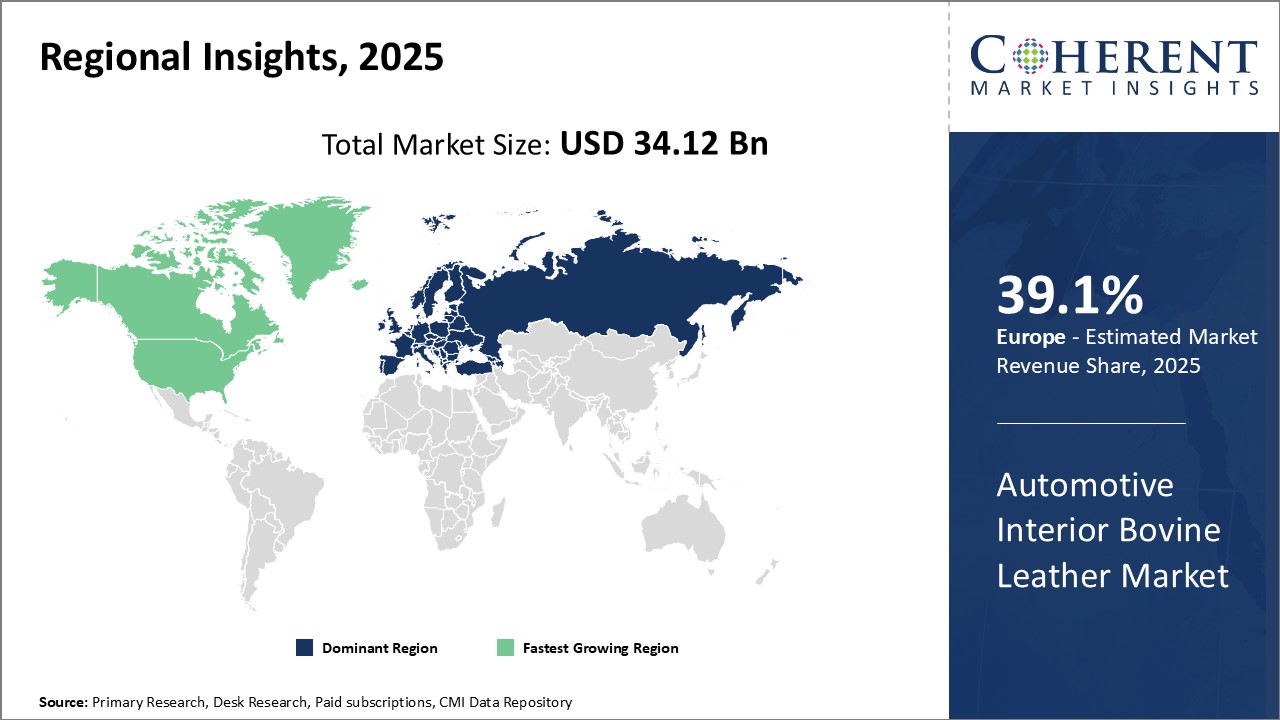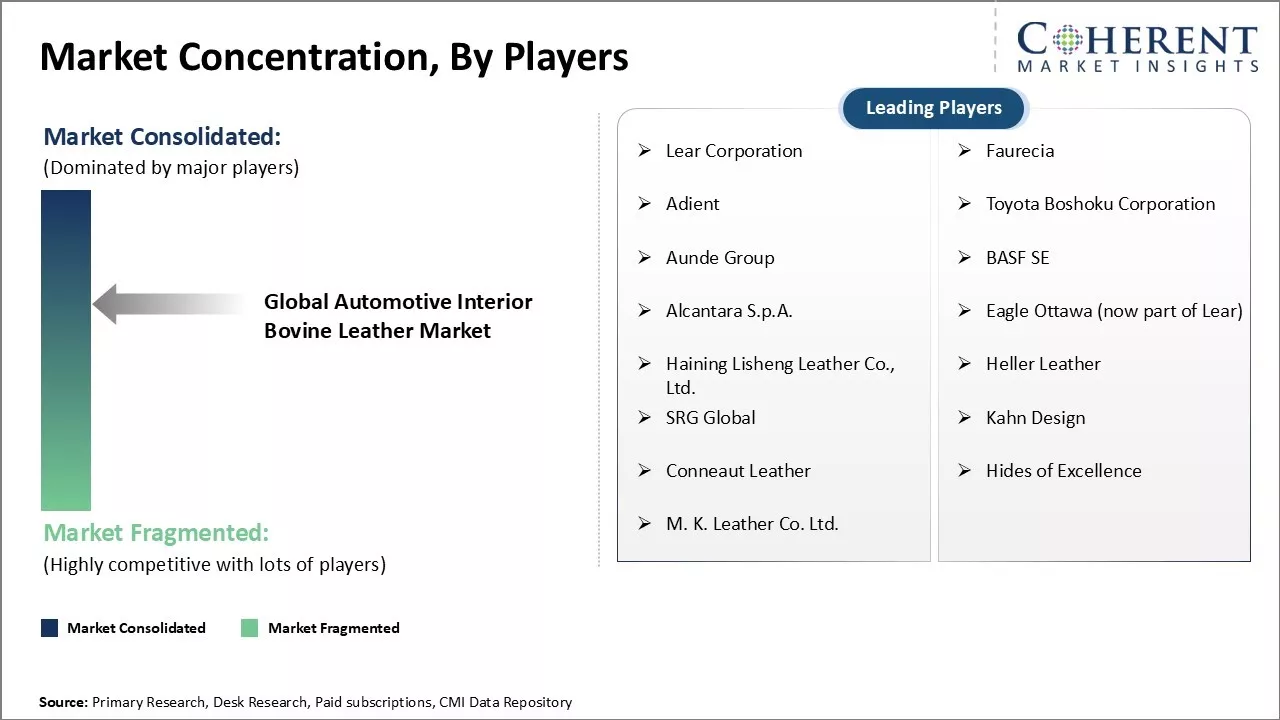Global automotive interior bovine leather market is estimated to be valued at US$ 34.12 billion in 2025 and is expected to reach US$ 52.70 billion by 2032, exhibiting a compound annual growth rate (CAGR) of 6.4% from 2025 to 2032.

Discover market dynamics shaping the industry: Download Free Sample
Increasing production of passenger vehicles globally along with growing demand for luxury and premium vehicles amongst consumers can drive the market growth. Key players in the automotive industry are focused on developing high-quality and aesthetically appealing leather interiors for vehicles in order to enhance the consumer experience. Rising discretionary income levels of consumers can also drive the preference for leather seats over regular fabric seats in vehicles in the near future. However, increasing adoption of synthetic and vegan leather materials amid sustainability concerns can hamper the market growth.

Discover high revenue pocket segments and roadmap to it: Download Free Sample
Insights, By Product Type- Durability and Aesthetics Boosts Demand for Full Grain Leather
In terms of product type, full grain leather segment is estimated to hold the highest market share of 33.0% in 2025, owing to its superior durability and aesthetic appeal. Being the unaltered natural surface of hide or skin, full grain leather retains all of the animal's natural markings, veins and pores. This makes it highly durable and weather resistant as the leather's top protective coat has not been removed. The natural markings and irregularities provide full grain leather a unique and luxurious look over split or bonded leather alternatives.
Insights, By Vehicle Type- Increasing Demand for Passenger Vehicles Boosts Market Share For Seats.
In terms of vehicle type, passenger vehicles segment is estimated to hold the highest market share of 38% in 2025, owing to rising vehicle ownership and demand for comfort features. As populations and incomes rises globally, passenger car continues to expand. Customers are increasingly prioritizing in-cabin experiences such as premium seating. Leather upholstery enhances comfort through its natural breathability and is considered a luxury aspect amongst buyers.
Insights, By Application- Multiple Areas of Application Boost Leather Usage beyond Seats
In terms of application, seats segment is estimated to hold the highest market share of 44% in 2025, Beyond the seating areas that have traditionally embodied vehicle luxuriousness, automakers are leveraging leather finishes in multiple secondary touchpoints to enhance interior aesthetics and feel.

Need a Different Region or Segment? Download Free Sample
Dominating Region- Europe
Europe is expected to dominate the automotive interior bovine leather market with an estimated market share of 39.1% in 2025, due to strong presence of premium automotive brands like BMW, Audi, and Mercedes-Benz. The region has favorable government policies promoting the use of high-quality leather interiors.
Fastest-Growing Region- North America
North America region exhibits the fastest growth in automotive interior bovine leather market. Rapid economic development and rising disposable incomes in countries like China and India have increased demand for vehicles with luxury interiors. Local manufacturing hubs aid industry expansion.
Automotive Interior Bovine Leather Market Outlook for Key Countries
China- China automotive interior bovine leather market growth is driven by the country's position as the largest automotive producer globally. Homegrown luxury brands are boosting leather consumption.
Germany- Germany automotive interior bovine leather market lead with innovations in leather craftsmanship and integration of advanced technologies
India- Growing at an impressive pace, India automotive interior bovine leather market is supported by strong Make-in-India initiatives luring global OEMs
U.S.- The U.S. automotive interior bovine leather market automakers are responding to consumer preference for premium vehicle experiences with expanded leather offerings
Japan- Japan automotive interior bovine leather market is dominated by renowned automakers noted for their emphasis on high-quality interiors and craftsmanship

Get actionable strategies to beat competition: Download Free Sample
Top Strategies Followed by Global Automotive Interior Bovine Leather Market Players
Established Players- R&D Investment
Leading companies in the global automotive interior bovine leather market focuses tremendously on research and development activities to come up with innovative product offerings. For instance, major players like Eagle Ottawa and Bader GmbH invests over 5% of their annual revenues in R&D each year.
Mid-Level Players- Cost-Effective Solutions
Mid-sized companies in the industry aim to deliver affordable products targeting cost-conscious customers. These focus on optimizing costs throughout the value chain from procurement to production. Some companies employ cost control strategies like negotiating better prices from suppliers, utilizing manufacturing technologies that enhance efficiencies, and adopting lean practices to eliminate wastages.
Small-Scale Players- Niche Specialization
New entrants in the market focuses on specific niche areas often overlooked by larger players. For example some focused on producing distinctive perforated or textured leathers tailored for the aftermarket segment. Others targeted developing countries in Asia Pacific and Latin America with affordable leathers catering to local automakers.
Emerging Startups in the Global Automotive Interior Bovine Leather Market
Innovative Technologies- Smart Sensors
Several startups are introducing advanced technologies like smart sensors integrated with bovine leather surfaces. For instance, Nanoleq developed a fingertip-sized smart sensor that can be embedded between leather layers to monitor health parameters of drivers. Using AI and cloud connectivity, it analyzes biometric data to detect driver drowsiness or vital signs during emergencies.
Sustainable Solutions- Eco-Friendly Materials
Emerging companies are focusing on developing more sustainable solutions. Recylex converts used and defective leather scrap into an animal-free fiber that can be reused to manufacture new leather. Their process helps reduce industrial waste and promotes circular economy principles.
In February 2024, Aunde Group, a prominent global supplier of high-quality automotive textiles and materials, unveiled a new collection of bovine leather specifically designed for electric vehicle interiors. This innovative collection highlights Aunde Group's commitment to advancing sustainable and stylish solutions tailored to the evolving needs of the electric vehicle market.
In August 2023, Katzkin, a leading provider of custom automotive interiors, announced the acquisition of the Roadwire automobile leather business's assets. This strategic move enhances Katzkin's capacity to cater to a diverse clientele, including OEMs, dealers, and thousands of restylers, while ultimately benefiting millions of consumers driving Katzkin-equipped vehicles. The acquisition marks a significant expansion in Katzkin’s service offerings.
In March 2023, BASF SE, a global leader in chemical manufacturing and materials science, introduced a new range of high-performance coatings specifically developed for bovine leather used in vehicles. This latest innovation demonstrates BASF SE's dedication to enhancing the durability and aesthetics of automotive interiors, offering advanced solutions that meet the rigorous demands of the industry.
Key Takeaways from Analyst
Automotive Interior Bovine Leather Market Report Coverage
| Report Coverage | Details | ||
|---|---|---|---|
| Base Year: | 2024 | Market Size in 2025: | USD 34.12 Bn |
| Historical Data for: | 2020 To 2024 | Forecast Period: | 2025 To 2032 |
| Forecast Period 2025 to 2032 CAGR: | 6.4% | 2032 Value Projection: | USD 52.70 Bn |
| Geographies covered: |
|
||
| Segments covered: |
|
||
| Companies covered: |
Lear Corporation, Faurecia, Adient, Toyota Boshoku Corporation, Aunde Group, BASF SE, Alcantara S.p.A., Eagle Ottawa (now part of Lear), Haining Lisheng Leather Co., Ltd., Heller Leather, SRG Global, Kahn Design, Conneaut Leather, Hides of Excellence, and M. K. Leather Co. Ltd. |
||
| Growth Drivers: |
|
||
| Restraints & Challenges: |
|
||
Uncover macros and micros vetted on 75+ parameters: Get instant access to report
Market Driver - Increasing vehicle production
The automotive industry has witnessed tremendous growth due to rising incomes and expanding middle class globally. Particularly in emerging economies such as China, India, Brazil, and Mexico, there has been increase in vehicle sales. Lower interest rates and easy financing options have also made car ownership more affordable. According to the International Energy Agency's Global EV Outlook 2022 report, the global electric car stock exceeded 16 million in 2020 and is estimated to grow more than tenfold to over 145 million cars by 2030.
Market Challenge - High price of raw materials
Global automotive interior bovine leather market faces significant environmental challenges. Bovine leather tanning is a heavily polluting industry that relies on chemicals such as chromium, coal tar, solvents and other toxins which damage the environment if not properly treated before disposal. According to the US Department of Labor statistics, the average price of hot-rolled steel sheet increased by over 48% from December 2020 to December 2021
Market Opportunity- Growing demand for eco-friendly leather
Increasing focus on environmental protection and sustainability presents a major opportunity for global automotive bovine leather market to adopt greener solutions. Leather producers can tap into this demand by developing new vegetable-tanned or chromium-free leather varieties which produce less wastewater and emissions. According to a 2021 report by the United Nations Food and Agriculture Organization, global meat consumption is projected to increase almost 15% by 2030
Share
Share
About Author
Gautam Mahajan is a Research Consultant with 5+ years of experience in market research and consulting. He excels in analyzing market engineering, market trends, competitive landscapes, and technological developments. He specializes in both primary and secondary research, as well as strategic consulting across diverse sectors.
Missing comfort of reading report in your local language? Find your preferred language :
Transform your Strategy with Exclusive Trending Reports :
Frequently Asked Questions
Joining thousands of companies around the world committed to making the Excellent Business Solutions.
View All Our Clients